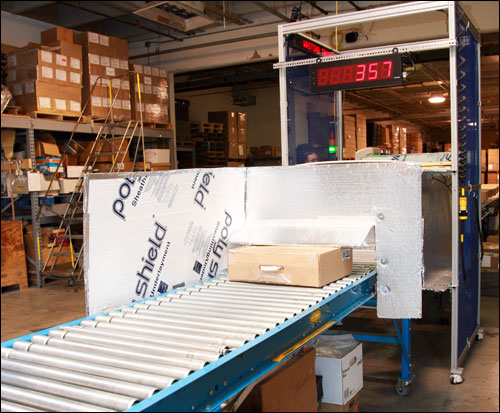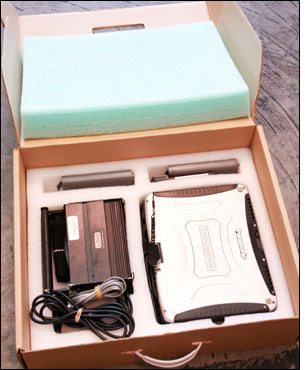May 05, 2011In the aftermath of a recent series of tornadoes and floods that devastated portions of the southeastern United States, government contractor Partnership for Response and Recovery (PaRR) Inspections is employing radio frequency identification to help it distribute Federal Emergency Management Agency (FEMA) inspection kits to its field workers efficiently, and to ensure that all items within those kits are accounted for after inspections are completed. By attaching EPC Gen 2 ultrahigh-frequency (UHF) RFID tags to each kit's contents, PaRR has an automated way of tracking which personnel have which items, and ensuring all items are ultimately returned . The solution, known as AssetTrax, was provided by North Carolina asset-tracking firm Entigral Systems.
When a federal disaster is declared, FEMA's inspection contractors send field workers to assess claims for homes and businesses damaged or destroyed. The workers are issued kits filled with a variety of FEMA-owned electronic equipment—typically, a laptop computer, a camera, batteries and battery chargers—necessary for gathering data that is then usually stored on the devices and sent to a back-end server once an Internet connection can be found. The kits, says Booth Kalmbach, Entigral Systems' chief technology officer, "contain everything they need to get their work done autonomously." At the end of a disaster-assessment project, the workers return the equipment to their employers, who are responsible for managing the FEMA assets. Often, items end up lost, or kits become mixed up between numerous inspectors who may, for example, be sharing a hotel room.

PaRR Inspections began working with Entigral Systems approximately three years ago to develop an RFID-based solution that would allow an inspection company to track not only who had checked out or returned kits, but also the items themselves. The recent series of devastating storms, however, provided the first comprehensive tryout of the entire kit-tracking solution. "We've tested different components of the system," says Doug Frost, PaRR's executive director, "but there hadn't been any large scale-disaster."
That changed with the tornadoes that struck North Carolina on Apr. 16. PaRR sent inspectors into the area for FEMA, providing them with kits containing as many as 18 items. Each object had a passive EPC Gen 2 UHF RFID tag attached to it, while the carrying case that holds the items was fitted with a similar tag. The kits were shipped to a field office on tagged pallets. Finally, inspectors were issued RFID-enabled badges to link them with the kits they received for their work.

Shortly after the tornadoes struck North Carolina, a series of storms damaged homes and businesses in Tennessee, Arkansas and Virginia, with flooding causing another natural disaster in Kentucky. By early May, Frost says, PaRR had sent between 400 and 500 inspectors into the field. With the AssetTrax system, the government contractor can more easily document the locations of kits and their contents, as well as the individual inspectors to whom they are assigned—based on RFID readings of the tags as inspectors receive and then return the kits.
Over the past three years, PaRR Inspections has tagged approximately 65,000 pieces of equipment, along with 6,000 cardboard or polyethylene carrying cases in which they are stored. Each kit is designed for a specific type of disaster. The kit for a hurricane, for instance, differs from those for tornados or flooding, since different equipment is required to measure the damage. Therefore, PaRR needs to store information regarding the specific items in each kit, and ensure that the proper kits are used at the correct location, and that all contents are in their carrying case when a kit is returned.
A UHF Gen 2 RFID label, printed with the tag's ID number in bar-coded form, is attached to each pallet. PaRR's employees use a handheld device to scan the pallet's bar-code number, then marries the tag ID of the pallet to all of the kits. All data is stored in the AssetTrax software residing on PaRR's back-end system. When a pallet loaded with kits is moved into the warehouse for storage, staff members at that site scan a bar-code number on a sticker attached to the shelf, and that bar-code number is also linked to the pallet's tag ID in the AssetTrax software.
In the event that an emergency occurs, the specific pallets bearing kits required at field offices are identified in the database. Workers locate the necessary pallets in the warehouse, based on the shelf's bar-code number, and the pallets are then sent to the appropriate field office. PaRR currently maintains field offices in North Carolina and Alabama, and may open additional field offices in other states.
Each field office is equipped with Motorola XR450 and FX7400 fixed RFID readers, cabled to laptops. Upon reporting to a field office, an inspector is provided with an ID badge. That individual's photo, name and title are printed on the front of the badge, while the unique ID number encoded to the badge's embedded EPC Gen 2 RFID tag is linked with his or her name in the AssetTrax software, loaded on a local computer. (Typically, there is no Internet access at field offices, due to the destruction of local communications infrastructure). When the inspector is assigned a kit, the ID number of that kit's RFID tag and the ID on the individual's badge are each read using the XR 450 reader, and are linked together in the software.
Once the inspector's service is finished—often weeks later—he or she returns the kit to the field office, at which time the FX7400 RFID reader is used to interrogate the ID numbers of the tags attached to the kit's carrying case and all equipment stored within it. This reader is surrounded by an RF-blocking enclosure in which the entire kit, together with the inspector's badge, can be placed, to ensure that no stray reads of other kits or equipment occur. This is a concern, Kalmbach explains, since at the time of the kits' return, there are typically many kits piled in the vicinity, and stray reads would confuse the returning process. The AssetTrax software compares information from the reads with stored data indicating which items should be included in that particular kit, in addition to the name of the particular inspector to whom that kit had been issued. In the event of a discrepancy, such as equipment missing or an inspector returning the wrong kit, an alert is displayed on the field location's PC, and staff members can then address the problem.
Because the inspections are still underway, Frost says, he can not report on how well the RFID system may have improved the efficiency of distributing kits to inspectors, and processing the kits' return to the field office, or whether this process prevents items from becoming lost. However, he says, "Our goal is 100 percent [return of equipment]." In the past, some equipment was typically lost—an expense that both FEMA and PaRR had to cover—but RFID has made the process of sending kits to the field offices more efficient, Kalmbach reports. With the manual method, he says, serial numbers had to be written down or inputted for each item packed in a kit. Now, employees can simply read the tags in each kit.


